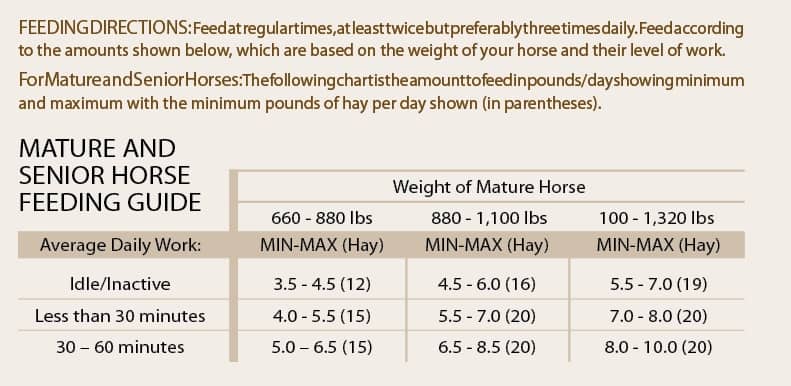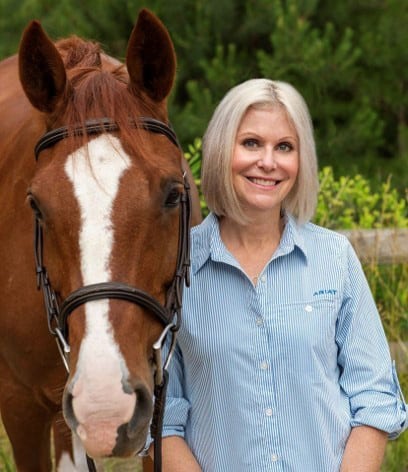Deciphering Your Feed Tag: Senior Horses

In the final installment of our three-part series, learn what nutrients are in your senior horse’s feed and why his body needs them.
As the years pass, we see shifts—both subtle and dramatic—that remind us our horses are aging. Backs sway, muscles atrophy, metabolisms slow or speed, coats develop flecks of gray, and bodies just aren’t as limber as they used to be. Some changes, such as those related to dentition and digestibility, can influence what these horses need in their diets. It’s at this point in a horse’s life that feeding a “senior feed” might become a necessity. Generally, you can tell a feed is formulated for senior horses by both its Association of American Feed Control Officials-regulated product name and its purpose statement. Looking at a feed’s guaranteed analysis and ingredients list can also tell you if it is suited for older horses. In this article we’ll describe some of the physical issues that cause horses’ nutrient needs to change and how a senior feed can meet those requirements.
Digestive Differences
Horses are born with all of their teeth embedded within their skull. Throughout a horse’s lifetime these teeth continuously erupt; all the while the horse wears them down with regular eating patterns. As horses age, the teeth change in a variety of ways, most noticeably in how they elongate and angle forward, which can affect the grinding surface for chewing. Very old horses (particularly those older than 25) can ultimately run out of teeth and be left with only gums. For these reasons, horse feeds designed for senior horses are often pelleted, pliable to the touch, and, therefore, easy to chew and break apart. Pellets also tend to absorb water readily, quickly forming a soft mash when soaked for horses with particularly bad teeth.
Several research groups over the years have investigated differences between older and younger horses’ nutritional requirements. In one study, in particular, researchers found that older horses were less able to digest protein, phosphorus, and fiber than adult (generally referred to as mature) horses. For this reason, senior feeds tend to have crude protein content in the 12-14% range, higher than what you might find in a feed designed for mature, idle horses. Many brands also supplement their senior feeds with individual amino acids, namely lysine, methionine, and/or threonine, that might be beneficial to older horses. Similarly, senior feeds typically contain slightly higher phosphorus levels (in the 0.5-0.65% range or more) to account for this reduced ability to digest. To ensure a strong calcium-to-phosphorus ratio of 2:1, these feeds might also contain higher calcium levels than feeds for mature horses.

The older horse’s hindgut (large intestine and colon) has a potentially reduced capacity to digest fiber, which it does by fermentation. This is problematic because fiber is very important for maintaining gastrointestinal health and motility. Senior feeds tend to be higher in fiber than other feeds, and manufacturers generally use more easily digested fiber sources, such as beet pulp, soybean hulls, rice bran, and alfalfa meal, which are typically the first ingredients listed on a senior feed label. The microbial organisms residing in the gut tend to ferment these fiber sources very well—more so than the fibers found in long-stem forages (hay).
Compared to feeds for other types of horses, senior feeds’ maximum crude fiber values tend to be at least 16%, with some in the 20% range. (Feeds for younger mature horses typically have fiber values in the 8-14% range.)
Feeds with high fiber content might be cross-labeled as “complete feeds,” which are designed to provide all the nutrition a horse needs, particularly if he’s not consuming traditional fiber sources such as hay or pasture.
Owners can feed older horses with compromised dentition complete feeds exclusively. However, for gastrointestinal health and motility, nutritionists still recommend including as many feedstuffs made up of longer-stem particles (such as found in chewed hay vs. chopped into hay cubes or further processed into commercial complete feeds) in the diet as the horse can tolerate.
If you do go the complete feed route, make sure you follow the manufacturer’s feeding recommendations on the label. Otherwise, you might need to provide a supplement to ensure your horse is receiving the vitamins and minerals he needs, says Carey Williams, PhD, equine Extension specialist at Rutgers University, in New Brunswick, New Jersey.
“For example, for a 1,000-pound horse the directions might read to feed 13 pounds of the product,” she says. “However, if feeding hay with the product, they will suggest a different amount based on the amount of hay fed, but they will recommend feeding no less than a certain amount. That only means it will not be providing a balanced diet to your horse.”

Some study results have shown that older horses have lower ascorbic acid (vitamin C) levels than their younger counterparts. Horses don’t require vitamin C because they can synthesize their own from glucose in their liver. These lower levels could reflect older horses’ reduced ability to synthesize their own vitamin C. Or, perhaps it indicates that older horses’ bodies use more vitamin C due to its strong antioxidant properties and their greater need for antioxidants to support immune function. Regardless, you will often note vitamin C (as ascorbic acid) on senior horse feed ingredient lists.
Vitamin E is another antioxidant with potential immune-enhancing properties. Because older horses’ cells might produce more oxidative and damaging products as a result of aging metabolism or other health issues, feeds designed for them often include higher amounts of vitamin E.
“If you are feeding a feed without added vitamin E or C, it might be a good idea to add a supplement with 1,000-2,000 IU of vitamin E per day and about 5-10 g of vitamin C,” Williams suggests. “This will help your horse cope with some of the stressful situations that come with aging, like a harder time thermoregulating during excessively hot or cold times, hauling or trail riding if starting to show symptoms of arthritis, or stress during feeding time if their pecking order has changed.”
You might also see that the manufacturer has added omega-3 fatty acids into its senior feed, which have potential anti-inflammatory as well as immune-enhancing properties. As older horses can be challenged in these areas, it’s a good thing to see omega-3s in these feeds. Similarly, you might notice various prebiotics and/or yeasts on the ingredients list to help improve fiber digestion and gut health.
Dr. Carey Williams
How to Feed
Instructions for feeding a senior horse depend on what (if any) forage he is consuming and his body weight. Feeding rate should also depend on the horse’s body condition score, which is a reflection of his fat coverage. Some older horses have a hard time maintaining weight and might require more feed than what is recommended on a tag.
While not specifically labeled on the guaranteed analyses, many feeds make claims about their low nonstructural carbohydrate (NSC, or sugar and starch) content. Here’s why: As a horse ages, metabolic changes can increase his risk for developing insulin resistance as well as the hoof disease laminitis. By lowering the starch and sugar levels in your horse’s diet, you’ll also lower his blood glucose concentrations and, thus, insulin concentrations following a meal.
“Try looking for a feed that has lower than 15% NSC, and if you test your pasture or hay, use this guideline as well,” says Williams. “If you are unsure about your forage and sampling is not an option, you can soak your hay for 30 to 60 minutes, which can remove about 30-50% of the NSC. Just make sure to remove the water before feeding. Also do not soak for longer or you could be losing other valuable nutrients like protein, calcium, or phosphorus.”
Selecting the feed with the right nutrient levels is not the only part of feeding a senior horse. Providing him with soft leafy forages is generally better than offering coarse hay, due to his aging dentition. Many veterinarians also recommend feeding older horses at chest level, rather than on the ground; this reduces the weight the horse bears on his forelimbs (feeding on the ground requires him to lower his head and shift his body weight farther forward). Extra pressure in the forelimbs can be problematic for older horses that have joint issues or have had bouts of laminitis.
Older horses also tend to drop in status in the herd pecking order, so you might need to bring them into a separate area for feeding (this also gives owners a chance to do daily checks on their older equids). Offering old horses water in buckets, or using automatic waterers with gauges, is a good way to track how much water they are consuming and might help you identify a potential water intake issue before dehydration or intestinal impaction sets in.
Take-Home Message
Lastly, senior feeds are not always just for old horses. There’s nothing in them that wouldn’t be appropriate for a mature horse. They provide excellent low-starch and sugar sources of protein and highly digestible fiber. Work with your equine nutritionist and veterinarian to ensure you’re meeting your aging horse’s nutrient needs while maintaining overall health.

Written by:
Shannon Pratt-Phillips, MSc, PhD
Related Articles
Stay on top of the most recent Horse Health news with















